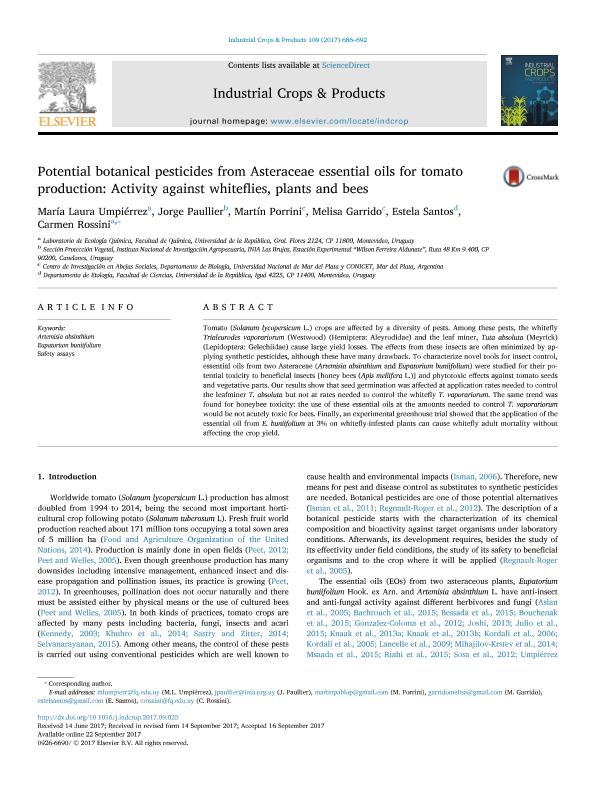Artículo
Potential botanical pesticides from Asteraceae essential oils for tomato production: Activity against whiteflies, plants and bees
Umpiérrez, María Laura; Paullier, Jorge; Porrini, Martín Pablo ; Garrido, Paula Melisa
; Garrido, Paula Melisa ; Santos, Estela; Rossini, Carmen
; Santos, Estela; Rossini, Carmen
 ; Garrido, Paula Melisa
; Garrido, Paula Melisa ; Santos, Estela; Rossini, Carmen
; Santos, Estela; Rossini, Carmen
Fecha de publicación:
12/2017
Editorial:
Elsevier Science
Revista:
Industrial Crops and Products
ISSN:
0926-6690
Idioma:
Inglés
Tipo de recurso:
Artículo publicado
Clasificación temática:
Resumen
Tomato (Solanum lycopersicum L.) crops are affected by a diversity of pests. Among these pests, the whitefly Trialeurodes vaporariorum (Westwood) (Hemiptera: Aleyrodidae) and the leaf miner, Tuta absoluta (Meyrick) (Lepidoptera: Gelechiidae) cause large yield losses. The effects from these insects are often minimized by applying synthetic pesticides, although these have many drawback. To characterize novel tools for insect control, essential oils from two Asteraceae (Artemisia absinthium and Eupatorium buniifolium) were studied for their potential toxicity to beneficial insects [honey bees (Apis mellifera L.)] and phytotoxic effects against tomato seeds and vegetative parts. Our results show that seed germination was affected at application rates needed to control the leafminer T. absoluta but not at rates needed to control the whitefly T. vaporariorum. The same trend was found for honeybee toxicity: the use of these essential oils at the amounts needed to control T. vaporariorum would be not acutely toxic for bees. Finally, an experimental greenhouse trial showed that the application of the essential oil from E. buniifolium at 3% on whitefly-infested plants can cause whitefly adult mortality without affecting the crop yield.
Palabras clave:
Artemisia Absinthium
,
Eupatorium Buniifolium
,
Safety Assays
Archivos asociados
Licencia
Identificadores
Colecciones
Articulos(CCT - MAR DEL PLATA)
Articulos de CTRO.CIENTIFICO TECNOL.CONICET - MAR DEL PLATA
Articulos de CTRO.CIENTIFICO TECNOL.CONICET - MAR DEL PLATA
Citación
Umpiérrez, María Laura; Paullier, Jorge; Porrini, Martín Pablo; Garrido, Paula Melisa; Santos, Estela; et al.; Potential botanical pesticides from Asteraceae essential oils for tomato production: Activity against whiteflies, plants and bees; Elsevier Science; Industrial Crops and Products; 109; 12-2017; 686-692
Compartir
Altmétricas



